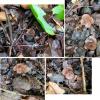
18-12-2025 17:23
 Bruno Coué
Bruno Coué
Bonjour,je serais heureux d'avoir votre avis sur c

18-12-2025 21:17
Pol DebaenstThe identification took me to Byssonectria deformi

18-12-2025 18:07
Margot en Geert VullingsThese plumes were found on rotten wood.They strong

17-12-2025 18:35
 Michel Hairaud
Michel Hairaud
Bonjour à tous/Hi to everyone I am passing along

15-12-2025 15:48
 Danny Newman
Danny Newman
Melanospora cf. lagenaria on old, rotting, fallen

15-12-2025 15:54
 Johan Boonefaes
Johan Boonefaes
Unknown anamorph found on the ground in coastal sa

15-12-2025 21:11
 Hardware Tony
Hardware Tony
Small clavate hairs, negative croziers and IKI bb

15-12-2025 07:09
 Danny Newman
Danny Newman
indet. Rutstroemiaceae sp. on unk. fallen leavesMc
Ciboria batschiana
B Shelbourne,
29-09-2024 13:17
• Confirmed by micro (spores, etc.).
• Some aspects remind me of Monilinia (johnsonii that I found in spring).
Habitat: Locally numerous but only found in one area, only growing from acorns of Quercus robur, some acorns still easily recognisable but pericarp always broken and loose, apparently growing on the cotyledons, slightly enlarged, blackened, somewhat decayed and mummified appearance, shallowly buried in leaf litter, damp area under mature trees, limited undergrowth, mixed deciduous woodland, Low Weald, England, late-September, after lots of rain.
Apothecia: Medium size, diameter < 13 (16) mm, stipe < 20 x 2 mm, length of stipe apparently environmental, initially cupulate, becoming more shallow and eventually discoid, caespitose, in groups of ~2-6 per acorn or cotyledon, receptacle and disk medium to dark reddish-brown (well camouflaged), darker with maturity, smooth and dull appearance, conspicuous wrinkling and some blackening around the base of the receptacle near the stipe, margin narrowing quite suddenly, usually slightly upturned, not exceeding the disc when mature, whitish when immature and blackish at maturity, round but slightly lobate in parts, undulating in maturity, stipe appears stromatised (blackened and burnt), sinuous, narrowing and darkening towards the base, tough and fibrous appearance, disc broadly plano-concave in maturity, blackish in the middle and often with small dark spots when (over) mature, usually umbonate, touching apothecia apparently fusing, sometimes with abundant whitish hyphae around the substrate.
Asci: Cylindrical-clavate, croziers, rings strongly bb, form seems typical of Sclerotinia, apex rounded to subtruncate when turgid (different views?), hemispherical to more acute-truncate when flaccid, uniseriate but slightly overlapping when turgid.
Spores: Irregularly ellipsoid-cylindrical, asymmetric in profile view, sometimes slightly reniform, poles rounded but usually slightly heteropolar with the base more attenuated, some spores more elongated, apparently more common in lower spores, ~2-4 tiny and shadowy LBs and two nuclei visible inside, apparently aseptate, germinating from the poles or the sides, usually one outgrowth.
Free living spores in water (not germinating): 9.2-10.7 (11.9) × 4.4-5.4 (5.6) µm, Q = (1.7) 1.8 - 2.3 (2.5), n = 30, mean = 10.1 × 5.0 µm, Q mean = 2.0.
Paraphyses: Cylindrical, often branching towards the apex, apex slightly to medium inflated and usually irregular to slightly antler-like (propoloid?), hymenium appears peachy colour but no VBs seen.
Excipulum etc. seem typical for Ciboria (at least several species seem to share the general structure).
Hans-Otto Baral,
29-09-2024 21:47

Re : Ciboria batschiana
Yes, and the binucleate spores are typical as I remember.
Note that the species is correctly Ciboria calyculus (not the same as Hymenoscyphus calyculus). See Hengstmengel paper here in the database.
B Shelbourne,
30-09-2024 10:40
Re : Ciboria batschiana
Thank you. I enjoyed reading the Hengstmengle paper and his discussion of the history. The Batsch account is reminiscent of my experience unearthing the first cotyledon.
It is great to highlight the connection to this historic observation, on the other hand, the narrowing of Batsch's species concept is enormous in current terms and presents us with an unfortunate epithet.
It is great to highlight the connection to this historic observation, on the other hand, the narrowing of Batsch's species concept is enormous in current terms and presents us with an unfortunate epithet.




 Sections-0003.jpeg
Sections-0003.jpeg